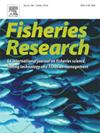模拟南大洋合作海食物网动态的生态系统模型的全局敏感性和不确定性分析
IF 2.3
2区 农林科学
Q2 FISHERIES
引用次数: 0
摘要
人们对开发和使用生态系统模拟模型为南大洋渔业管理提供建议的兴趣与日俱增。然而,由于对生态系统模型参数的不确定性的影响了解甚少,使得开发实用生态系统模型的工作进展缓慢。为了解决这个问题,我们探讨了在校准合作海 OSMOSE 生态系统模型("OSMOSE-合作海")过程中估计参数的不确定性及其影响。我们的研究涉及四类校准参数:(1) Plank.access,重点物种群可利用的背景物种群生物量比例;(2) Bioflux,控制洄游物种群生物量跨建模域边界通量的参数;(3) Mlarval,重点物种群的瞬时幼虫死亡率;(4) Mnatural,重点物种群的额外自然死亡率。莫里斯方法的结果表明,合作海群落对中下层鱼类幼体参数的变化最为敏感。齿鱼、阿德利企鹅(Pygoscelis adeliae)、海豹和鲸等体型大、寿命长的物种的生物量对这些物种群的特定参数最为敏感。相比之下,中上层鱼类和磷虾等体型小、寿命短的物种的生物量对这些物种群捕食者特定参数的变化最为敏感。蒙特卡洛模拟表明,群落动态对 Mlarval 和 Mnatural 参数的敏感性要高于 Plank.access 和 Bioflux 参数。在逐渐增加 Mlarval 或 Mnatural 参数后,阿德利企鹅、海豹和鲸鱼的生物量减少,而中上层鱼类和南极磷虾的生物量增加。本研究对校准过程中估算参数的不确定性进行了全面分析,是向支持合作海基于生态系统的管理的实用生态系统模型迈出的重要一步。本研究将为南大洋类似的生态系统建模工作奠定宝贵的基础。本文章由计算机程序翻译,如有差异,请以英文原文为准。
Global sensitivity and uncertainty analyses of an ecosystem model for simulating food web dynamics in the Cooperation Sea, Southern Ocean
There is growing interest in developing and using ecosystem simulation models to advise fisheries management in the Southern Ocean. However, poor understanding of the impacts of uncertainty in ecosystem model parameters slows down progress towards operational ecosystem models. To address this issue, we explored uncertainty in the parameters estimated during the calibration of an OSMOSE ecosystem model for the Cooperation Sea (“OSMOSE-CooperationSea”) and the impacts of this uncertainty. Our investigations pertained to four types of calibrated parameters: (1) Plank.access, the proportion of the biomass of background species groups available to focal species groups; (2) Bioflux, the parameter controlling the flux of migratory species group biomasses across the modelled domain boundaries; (3) Mlarval, the instantaneous larval mortality of the focal species groups; and (4) Mnatural, the additional natural mortality of the focal species groups. Results with the Morris method suggested that the community in the Cooperation Sea was most sensitive to changes in the Mlarval parameter of mesopelagic fishes. The biomasses of large-size, long-lived species such as toothfishes, Adélie penguin (Pygoscelis adeliae), seals, and whales were most sensitive to the parameters specific to these species groups. By contrast, the biomasses of small-sized, short-lived species such as mesopelagic fishes and krill species were most sensitive to changes in the parameters specific to the predators of these species groups. Monte Carlo simulations indicated that community dynamics were more sensitive to the Mlarval and Mnatural parameters than to the Plank.access and Bioflux parameters. After gradually increasing the Mlarval or Mnatural parameter, the biomasses of Adélie penguin, seals and whales decreased, while the biomasses of mesopelagic fishes and Antarctic krill increased. By providing a comprehensive analysis of uncertainty in the parameters estimated during the calibration process, the present study represents an important step towards an operational ecosystem model for supporting ecosystem-based management in the Cooperation Sea. The present study will serve as a valuable basis for similar ecosystem modelling efforts in the Southern Ocean.
求助全文
通过发布文献求助,成功后即可免费获取论文全文。
去求助
来源期刊

Fisheries Research
农林科学-渔业
CiteScore
4.50
自引率
16.70%
发文量
294
审稿时长
15 weeks
期刊介绍:
This journal provides an international forum for the publication of papers in the areas of fisheries science, fishing technology, fisheries management and relevant socio-economics. The scope covers fisheries in salt, brackish and freshwater systems, and all aspects of associated ecology, environmental aspects of fisheries, and economics. Both theoretical and practical papers are acceptable, including laboratory and field experimental studies relevant to fisheries. Papers on the conservation of exploitable living resources are welcome. Review and Viewpoint articles are also published. As the specified areas inevitably impinge on and interrelate with each other, the approach of the journal is multidisciplinary, and authors are encouraged to emphasise the relevance of their own work to that of other disciplines. The journal is intended for fisheries scientists, biological oceanographers, gear technologists, economists, managers, administrators, policy makers and legislators.
 求助内容:
求助内容: 应助结果提醒方式:
应助结果提醒方式:


